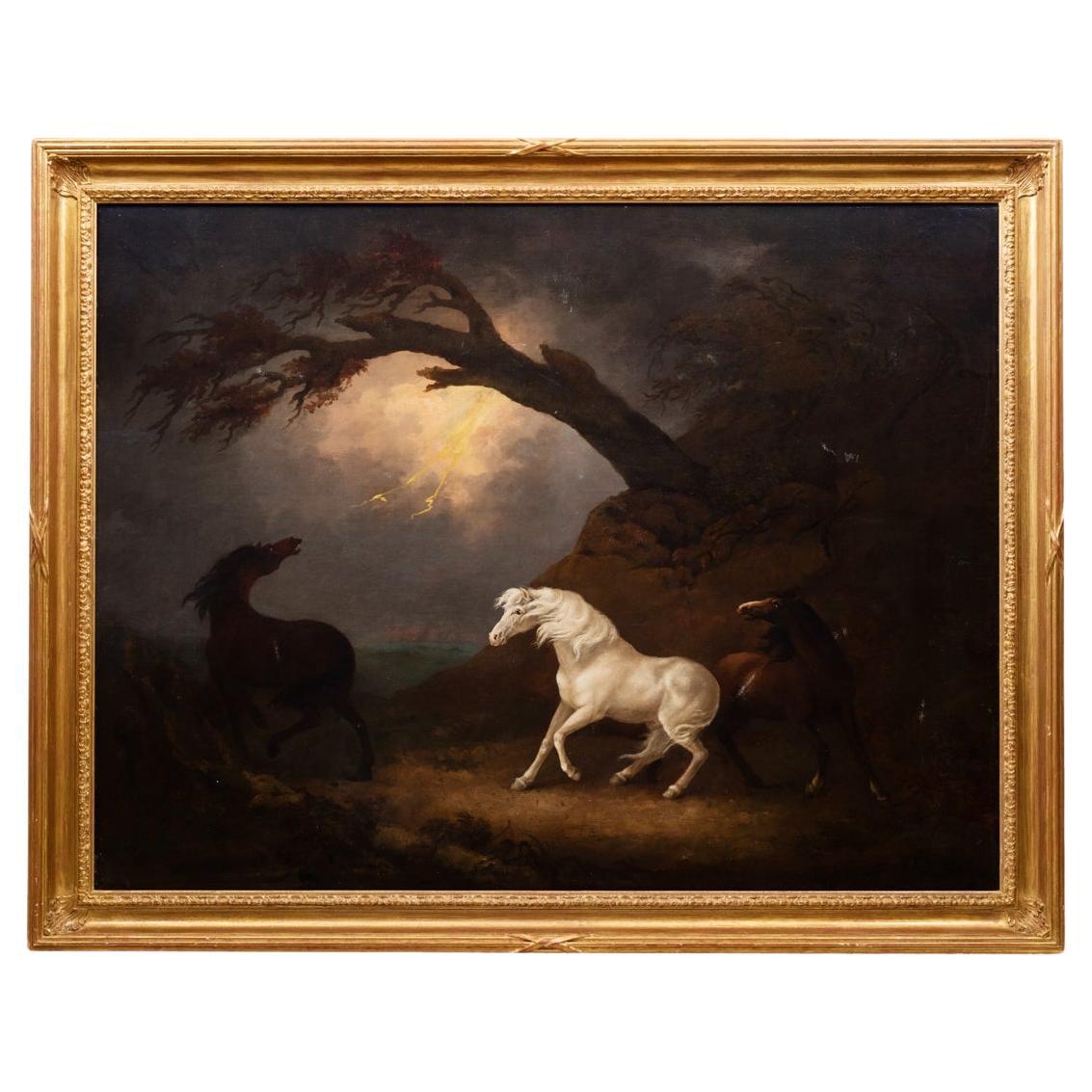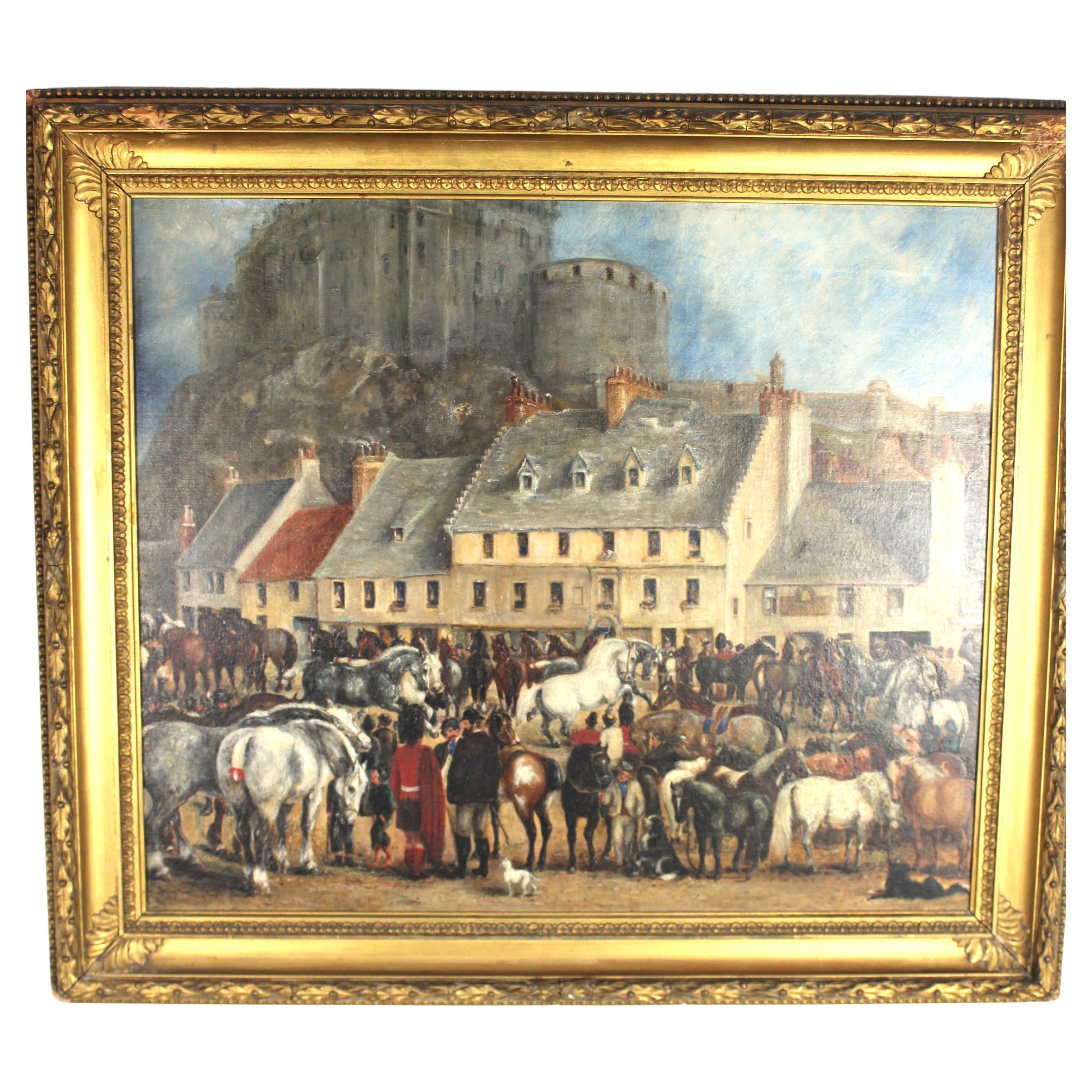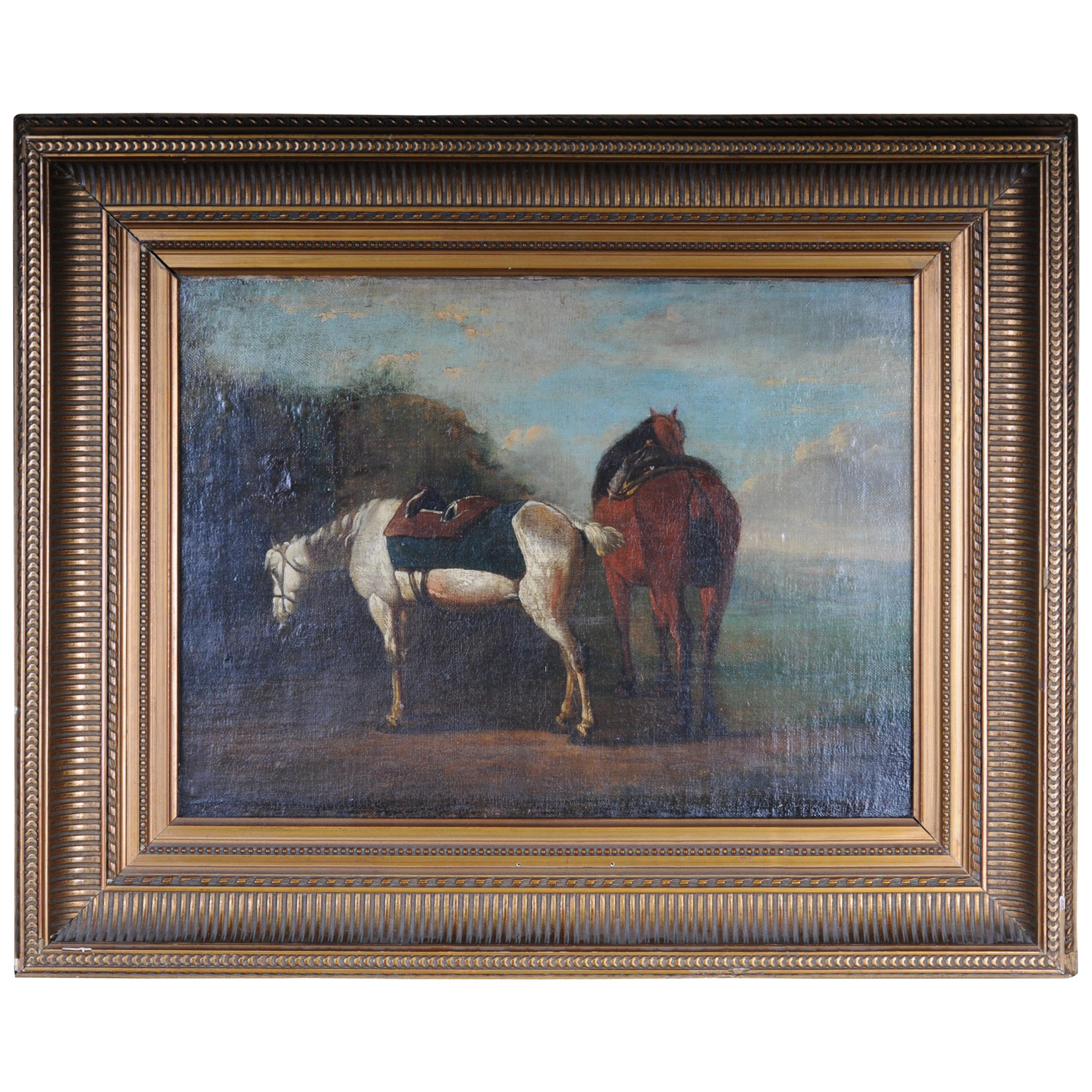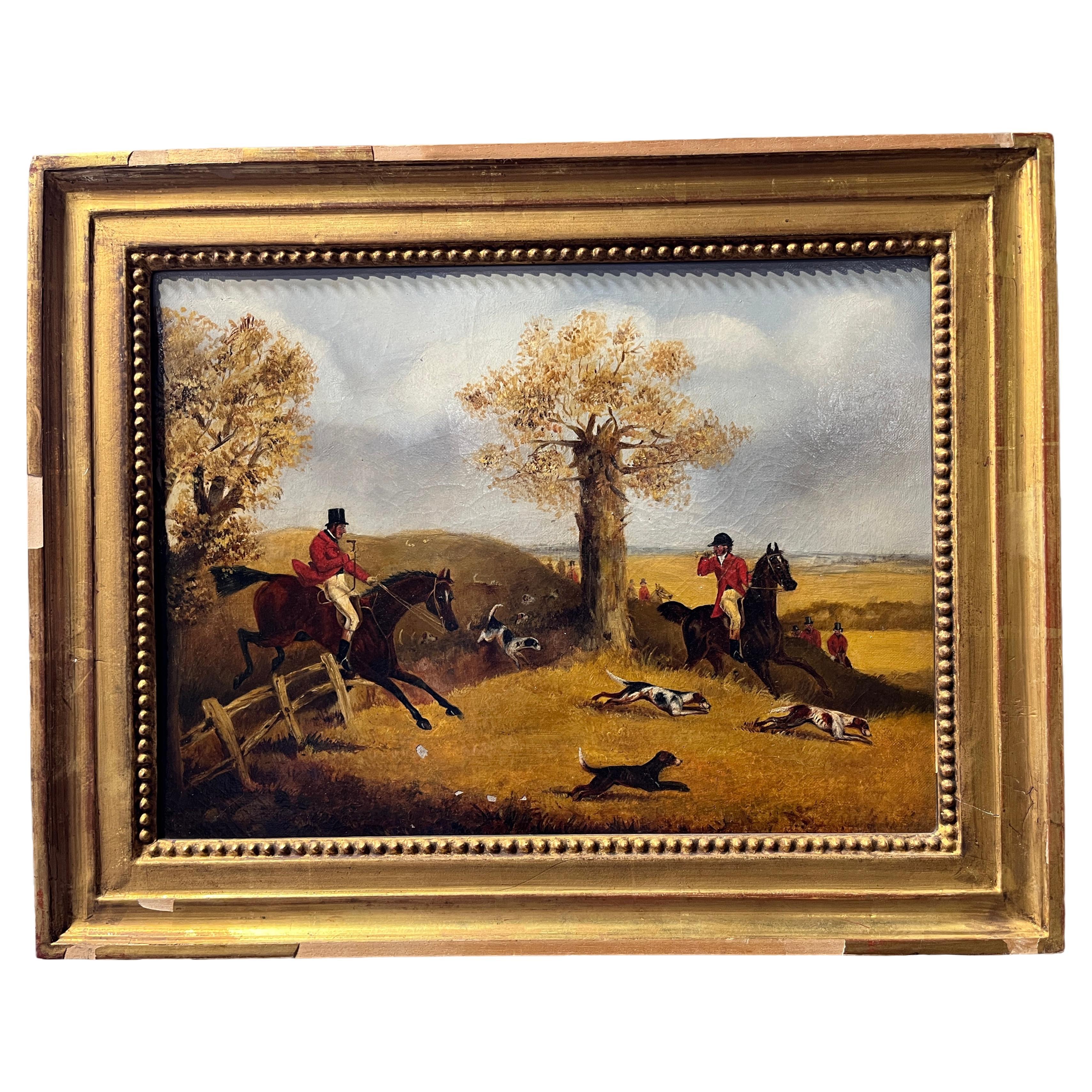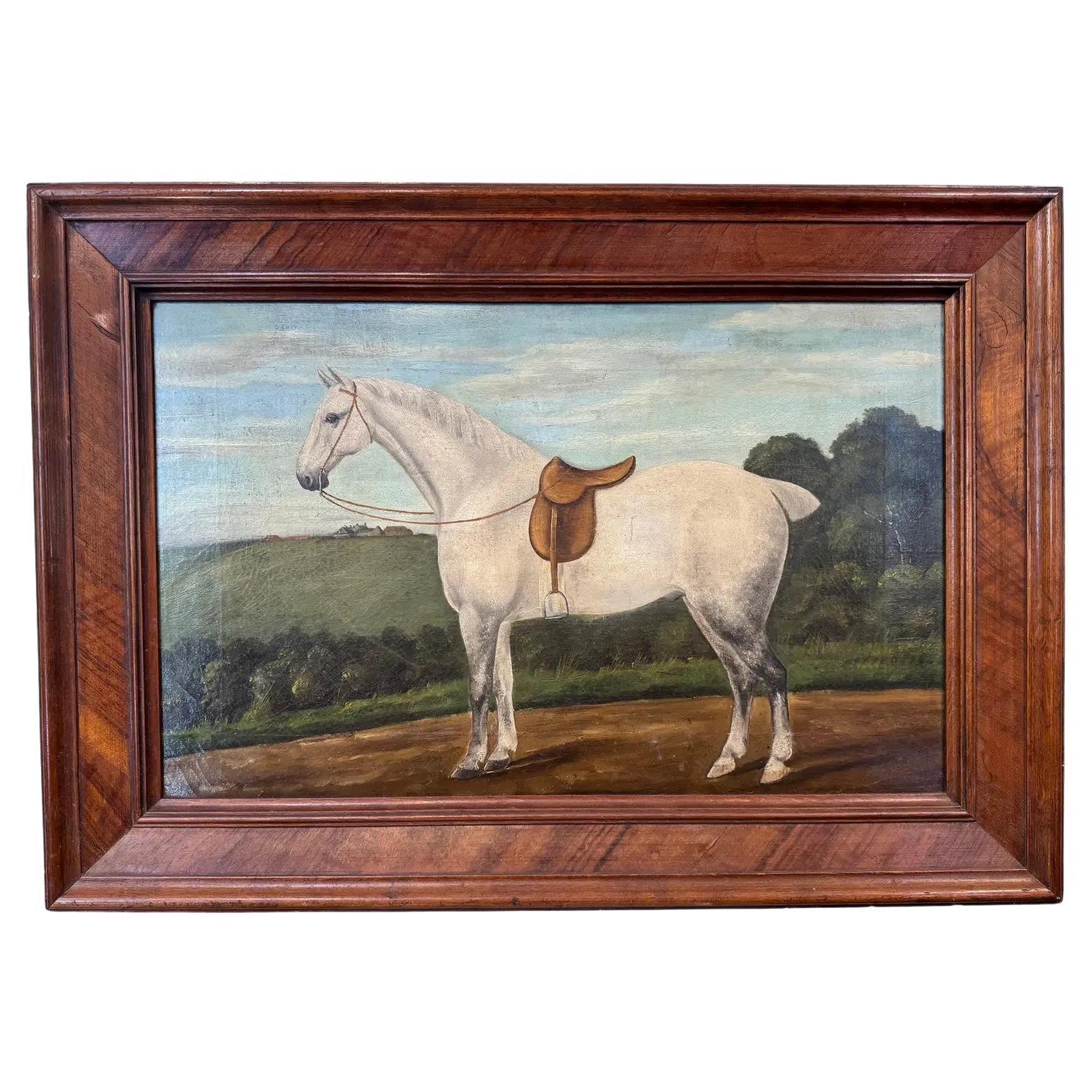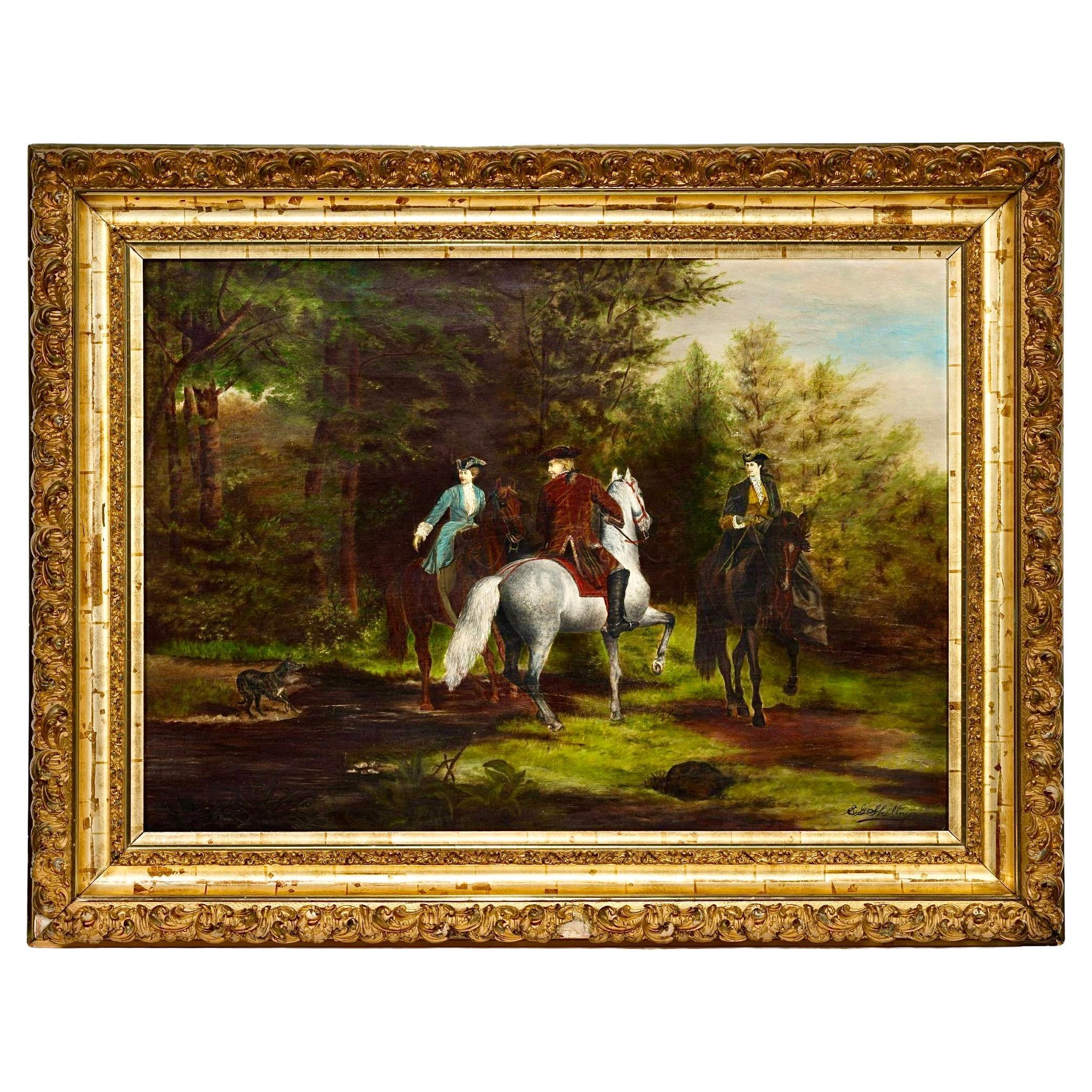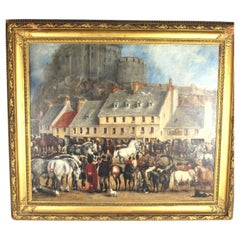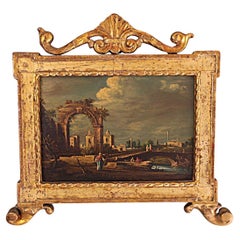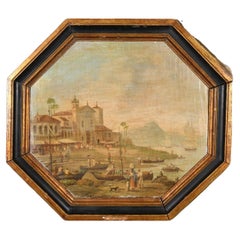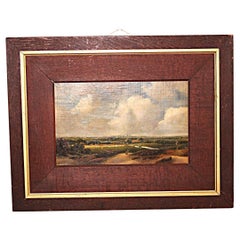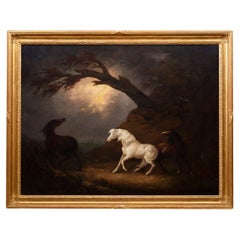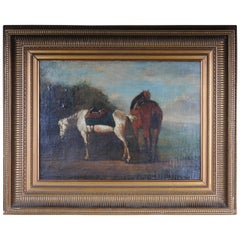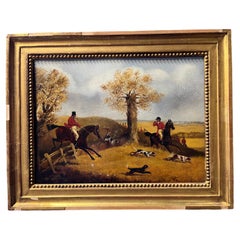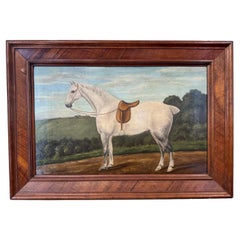Items Similar to Early 19th century horse painting
Want more images or videos?
Request additional images or videos from the seller
1 of 12
Early 19th century horse painting
$1,973.15
£1,450
€1,703.51
CA$2,710.78
A$3,026.33
CHF 1,585.75
MX$37,045.20
NOK 20,139.03
SEK 18,988.55
DKK 12,713.46
Shipping
Retrieving quote...The 1stDibs Promise:
Authenticity Guarantee,
Money-Back Guarantee,
24-Hour Cancellation
About the Item
A Timeless Depiction of the English Fox Hunt
The early 19th-century fox hunting scene, attributed to Dean Wolstenholme Elder, is a stunning representation of the aristocratic traditions associated with English countryside sports. This antique oil painting on canvas captures the essence of an era when fox hunting was not just a pastime but a cultural institution among the British elite.
Set in the rolling landscapes of Sussex, this painting embodies the rich history of 19th-century sporting art, a genre highly sought after by collectors of equestrian and hunting artwork. The detailed depiction of riders in traditional red hunting coats, accompanied by a well-organised pack of foxhounds, immerses the viewer in the heart of a classic English equestrian hunt.
Composition and Artistic Techniques
Triangular Arrangement for a Dynamic Flow
One of the most striking elements of this painting is its triangular composition, where the central figures—the huntsmen on horseback, the energetic pack of hounds, and the elusive fox—are arranged to create a natural flow of movement. The eye is instinctively drawn through the canvas, following the dramatic moment of pursuit, with the fox placed strategically in the lower right corner. This compositional approach enhances the sense of action and urgency, making the painting a compelling piece of fox-hunting artwork.
Realism with Romantic Influences
Dean Wolstenholme Elder, renowned for his sporting paintings, blends realism with romanticism, a hallmark of early 19th-century hunting art. The meticulous rendering of the foxhounds and horses showcases his deep understanding of their anatomy and movement. The landscape, depicted in a slightly looser style, provides a vibrant yet naturalistic backdrop, emphasizing the beauty of the English countryside.
Colour Palette and Light Interplay
The autumnal tones of the foliage, rich earthy greens, browns, and reds, evoke a nostalgic mood characteristic of the era. The vibrant red hunting coats contrast sharply against the subdued landscape, making them focal points that add visual depth and intrigue to the scene. The interplay of light and shadow is masterfully executed, with soft golden hues illuminating the riders and animals, reinforcing the sense of realism while enhancing the painting’s overall atmosphere.
Historical and Cultural Context of Fox Hunting
The Rise of Fox Hunting in 19th-Century Britain
The tradition of fox hunting dates back to the late 17th and early 18th centuries, evolving into a highly structured sport by the early 19th century. With the decline of deer populations and the Enclosure Acts of the late 18th and early 19th centuries, which privatised common lands, fox hunting became the dominant form of mounted hunting. The emergence of Masters of Foxhounds (MFH), organised kennels, and designated hunting territories solidified its place as a prestigious sport among the British aristocracy.
In regions like Sussex, where sprawling estates and enclosed farmlands provided ideal hunting terrain, fox hunting became a symbol of status, wealth, and equestrian prowess. Participation required access to well-bred horses, specialised hunting attire, and large estates, reinforcing its exclusivity among the upper class.
- Similar to:Dean Wolstenholme (Artist)
- Dimensions:Height: 17.33 in (44 cm)Width: 19.3 in (49 cm)Depth: 2.37 in (6 cm)
- Style:Regency (Of the Period)
- Materials and Techniques:
- Place of Origin:
- Period:
- Date of Manufacture:1810
- Condition:Wear consistent with age and use. Minor losses.
- Seller Location:Seaford, GB
- Reference Number:1stDibs: LU10376244774632
About the Seller
New to 1stDibs
Joined in the past six months.
No Reviews Yet
Vetted Professional Seller
Every seller passes strict standards for authenticity and reliability
Established in 2021
1stDibs seller since 2025
Typical response time: 1 hour
- ShippingRetrieving quote...Shipping from: Seaford, United Kingdom
- Return Policy
Authenticity Guarantee
In the unlikely event there’s an issue with an item’s authenticity, contact us within 1 year for a full refund. DetailsMoney-Back Guarantee
If your item is not as described, is damaged in transit, or does not arrive, contact us within 7 days for a full refund. Details24-Hour Cancellation
You have a 24-hour grace period in which to reconsider your purchase, with no questions asked.Vetted Professional Sellers
Our world-class sellers must adhere to strict standards for service and quality, maintaining the integrity of our listings.Price-Match Guarantee
If you find that a seller listed the same item for a lower price elsewhere, we’ll match it.Trusted Global Delivery
Our best-in-class carrier network provides specialized shipping options worldwide, including custom delivery.More From This Seller
View All19th-century Scotland Edinburgh Horse Fair Painting
By Rosa Bonheur
Located in Seaford, GB
A rare 19th-century painting of the Horsefair at the Grassmarket, Edinburgh, Scotland
Follower of Rosa Bonheur, oil on canvas
indistinctive collector wax seals verso.
19th-Century...
Category
Antique 1860s British High Victorian Paintings
Materials
Canvas
$8,226 Sale Price
20% Off
Antique Venetian capriccio oil painting
Located in Seaford, GB
Francesco Guardi Venice Oil Painting – Venetian Art in the Manner of Guardi
Exquisite 19th-Century Venetian Oil Painting
Experience the timeless elegance of Venetian art with this r...
Category
Early 20th Century Paintings
Materials
Pine, Paint
$1,687 Sale Price
20% Off
Early 19th century Capriccio Brazil School Painting
Located in Seaford, GB
Rare Early 19th century Capriccio view of Rio de Janeiro Painting
Probably painted circa 1810 by one of Jean-Baptiste Debret, Italian Students.
Painted on Sailcloth.
Historical Context of Early 19th Century Portuguese Colonial Brazil
1.1 Transition from Colony to Empire
During the early 19th century, Brazil underwent a seismic shift in its political status. Originally a colony under the Portuguese Empire, the arrival of the Portuguese Royal Court in Rio de Janeiro in 1808 rapidly elevated the city’s cultural and political importance. By 1815, Brazil was declared a kingdom united with Portugal, setting the stage for the emergence of the Empire of Brazil in 1822. This period of transformation—often termed the transitional period from colony to empire—fueled a wave of artistic production in cities like Rio de Janeiro.
1.2 European Artistic Influence in Brazil
With the French Artistic Mission in Rio (initiated in 1816) and the presence of various Portuguese and European artists, Brazilian art of the early 1800s began to reflect diverse influences, from neoclassical painting to the early rumblings of romanticism. Painters such as Jean-Baptiste Debret, and Nicolas-Antoine Taunay, and local luminaries like Manuel de Araújo Porto-Alegre contributed to the fine arts tradition in Brazil. Their works featured scenes of local life, portraits of Brazilian society, and imaginative vistas—sometimes referred to as “capriccios,” in which real elements were combined with artistic liberties to create an idealized panorama.
1.3 Rio de Janeiro as Cultural and Political Hub
Rio de Janeiro, often called the Imperial capital after Brazil’s independence, was home to foundational institutions like the Imperial Academy of Fine Arts (Academia Imperial de Belas Artes). Later evolving into the Escola de Belas Artes (School of Fine Arts in Rio), these academies nurtured the talents of emerging painters, who found patronage under the Royal Court and, subsequently, the Imperial Court. The city’s significance was further enhanced by the construction of significant buildings, the modernization of infrastructure, and the mingling of European courtly customs with the traditions of local inhabitants.
. Description of the Octagonal Oil on Canvas: A Capriccio View of Rio de Janeiro
2.1 Composition and Layout
The most striking characteristic of this 19th-century Brazilian art piece is its octagonal shape, a relatively unusual format that draws the viewer’s gaze toward its centre. The composition showcases Rio de Janeiro’s shoreline in the early 1800s, brimming with merchant ships and smaller boats anchored near the shore. On the sand, there is a bustling crowd of local people—men and women carrying food and goods on their heads, loading and unloading boats, and engaging in everyday commerce. The backdrop of soaring mountains suggests Rio’s iconic topography, embodying the landscape that famously defines the city.
2.2 Architectural and Religious Landmarks
On the left side, one can discern the silhouette of a church believed to be Santa Lucia, a significant religious structure in the heart of early 19th-century Rio. This element provides viewers with a tangible reference point, linking the scene to an actual location. However, because this painting is labelled as a “capriccio,” the artist might have taken creative liberties by rearranging or amplifying certain features of the city. The melding of real and idealized elements is characteristic of these imaginative vistas.
2.3 Evoking Daily Life in Colonial Rio
One of the painting’s greatest appeals lies in its portrayal of daily life during the colonial era. Men and women from various backgrounds populate the scene. Some appear to be carrying goods on their heads, a common practice in Brazil that has persisted through different centuries. Others appear to be haggling or trading near small vessels, revealing the commercial pulse of an active port city. This focus on local people, combined with the grandeur of merchant ships, captures the tension and synergy between the every day and the extraordinary—a hallmark of Brazilian colonial painting that balances the grand narratives of empire with the rhythms of ordinary life.
2.4 An Amalgamation of Neoclassical and Romantic Influences
Although academic art in early 19th century Brazil was highly influenced by neoclassicism, the onset of romanticism can be spotted in the emotional portrayal of the sky, the lively palette, and the dramatic emphasis on nature’s beauty (the mountains, in particular). This duality reflects the fine arts tradition in Brazil during the transitional phase when artists were embracing multiple styles. As part of the School of Rio or the Rio de Janeiro school, painters often integrated academic techniques learned from European masters with emerging local subjects and influences.
3. Institutions and Artistic Movements
3.1 Imperial Academy of Fine Arts
Originally known as the Royal School of Sciences, Arts, and Crafts, the Imperial Academy of Fine Arts in Rio de Janeiro was instrumental in shaping 19th-century Brazilian art. Influential artists and teachers from Portugal, France, and other European nations congregated at the Academy, imparting their expertise to native students. As the monarchy consolidated power, the Academy enjoyed royal patronage, leading to the creation of Imperial Academy-style works that combined European academic rigour with Brazilian-themed subject matter.
3.2 Impact of the French Artistic Mission
The French Artistic Mission, which arrived in 1816, played a pivotal role in introducing advanced European artistic techniques, thereby elevating the overall quality of painting in Brazil. Artists like Jean-Baptiste Debret not only documented Brazilian society but also spearheaded the development of a local visual identity that aligned with both academicism and the national context of a blossoming empire. Debret, alongside others such as Nicolas-Antoine Taunay, mentored Brazilian artists, sowing the seeds of what would become the Brazilian academic art movement.
3.3 Religious, Historical, and Landscape Paintings
In addition to everyday scenes and historical compositions, religious iconography remained crucial throughout Portuguese colonial and imperial Brazil. Churches were omnipresent in cityscapes like Rio de Janeiro. Many colonial-era Brazilian portraits...
Category
Antique Early 19th Century Brazilian Spanish Colonial Paintings
Materials
Canvas
$2,961 Sale Price
20% Off
Dutch 19th century Landscape Painting
By Andreas Schelfhout
Located in Seaford, GB
This charming oil-on-paper painting captures a serene landscape near Haarlem, evocative of Andreas Schelfhout's masterful Dutch Romantic style. The work features a quintessentially D...
Category
Antique Late 19th Century Dutch Late Victorian Paintings
Materials
Paint, Paper
Exquisite 19th Century English Still Life of wild flowers– Oil on Wood Panel
Located in Seaford, GB
A captivating and finely executed 19th-century English still life painting, rendered in oil on wood panel, depicting an abundant bouquet of mixed flowers in a terracotta urn. This hi...
Category
Antique 19th Century English High Victorian Paintings
Materials
Paint
18th century of circle Richard Wilson pastoral Landscape
By Richard Wilson R.A.
Located in Seaford, GB
18th-Century Richard Wilson Landscape – A Masterpiece of British Old Master Art
This 18th-century Richard Wilson landscape, attributed to the circle of Thomas Jones, is a stunning pastoral landscape oil painting that embodies the charm of Georgian-era countryside artwork. As a fine example of British old master landscape art, this piece showcases the elegance and natural beauty of the English countryside, making it a perfect addition to any collection of antique rural landscape art.
A Romantic Countryside Painting with Timeless Appeal
The composition of this romantic countryside painting is thoughtfully balanced, featuring lush greenery, rolling hills, and a tranquil sky. The English countryside oil painting...
Category
Antique 18th Century English Georgian Paintings
Materials
Canvas
You May Also Like
19th Century Oil On Canvas Equestrian Painting
Located in Dublin 8, IE
19th Century oil on canvas painting, depicting an atmospheric scene of three horses to foreground with a thunderstorm in the background. Dramatic tension is created by the play of light and shadow and is heightened by the bolt of lightning...
Category
Antique 19th Century European Paintings
Materials
Canvas, Paint
Old Oil Painting Illustration 2 Horses on the Landscape
Located in Berlin, DE
(S - 206)
Oil of canvas
Old painting circa 20th century.
Fine quality.
Category
20th Century Paintings
Materials
Wood
19th Century English Painting "Fox Hunting"
Located in Scottsdale, AZ
19th Century English Painting "Fox Hunting". Beautiful scene of a hunt in action. See photos.
Category
Antique 19th Century English Victorian Paintings
Materials
Canvas, Paint
$1,200 Sale Price
20% Off
19th Century Equstrian Art
Located in Nashville, TN
This 19th century english painting of a grey horse is perfect for a horse lover or simply someone who admires a beautiful painting. The horse, standing in front of the woods, is sadd...
Category
Antique Early 1900s English Paintings
Materials
Paint
English Equestrian Scene Oil on Canvas Painting by Elizabeth Shelly
Located in Bradenton, FL
19th Century English Equestrian Scene Oil on Canvas Painting by Elizabeth Shelly. Painting features riders in formal riding attire with three riders and a dog in a wooded area. The f...
Category
Antique 19th Century Romantic Paintings
Materials
Canvas, Giltwood
French Victorian Horse Regimen Painting
By Breaad
Located in Queens, NY
French Victorian (19th Cent) oil painting of French regiment on horseback (signed BAIRD) in gilt frame
Category
Antique 19th Century French Victorian Paintings
Materials
Paint
More Ways To Browse
Hunting Coat
Hunt Hounds
Hound Fox Hunting
Golden Deer
Antique Hunting Pack
Butterscotch Bakelite
Ceramic Persian Tile
Cerused Oak Chest
Champleve Urn
Chinese Bronze Elephant
Chinese Carved Stone Animals
Chinese Dragon Cabinet
Chinese Embroidery Bird
Chinese Low Kang Tables
Chinese Oil Lamp
Chinese Porcelain Immortal
Chinese Scroll Weights
Chinese Silk Painting Birds
